7+ Organizational Policy Examples to Download
A workplace without rules and policies for workers to abide to is certainly a recipe for disaster. Policies serve a vital purpose in strengthening, supporting, and protecting an organization and its people. These are applied to form boundaries for acceptable behavior within the workplace, and serve as a guideline for the best practices in particular office situations. This is done to ingrain values and norms that contribute to the general culture of the company as well. You may also see marketing policy.

Policies and Procedures in Business
Company policies and procedures are an essential part of any given organization. These are employed to protect the rights of company employees as well as the interests of employers. This is to establish the rules of conduct within an entity, outlining the function of both employers and the organization’s workers. This may include employee conduct, dress code, attendance, privacy, and other related conditions, depending on the needs of the organization.
Initiating structured policies and procedures can aid an organization in running more effectively and systematically. With this, members of the organization are provided a simplified description and a deeper understanding of the formal structure of the organization they are a part of.You may also see training policy.
One example of a policy that must be implemented to guide the company in achieving its defined objectives are the organization’s financial policies. This policy would help monitor and manage the financial expenditures of the company, along with tracking all monetary transactions and applying adequate statutory reporting requirements. The company must also establish a mechanism that ensures accurate and timely recording of every financial data to the management responsible for handling these reports.You may also see drug and alcohol policy.
In applying new organizational policies, the organization must see to it that its entire staff becomes a fundamental part of these changes. In most cases, the organization would conduct employee surveys to point out key issues that may be affecting the overall structure of the company before these policies have been applied. Apart from asking specific questions that center on the organization as a whole, the survey must also include general questions regarding its respondents. This includes a list of their responsibilities, the entity’s chain of command, as well as organizational reporting mechanisms that exist.You may also see employee email policy.
Additionally, seeing how new policies may affect the company’s current day-to-day operations must also be considered beforehand. To do so, the organization must examine the specific roles of staff members, observe how they utilize their time, study the current workflow layout, and analyze the organization’s past performances.You may also see disciplinary action policy.
However, it’s also important to take note that the company may not fully assess the impact of the new organizational policies unless it has already been implemented. Here, the organization must evaluate and compare the mission and vision statements of the company, as well as the strategic objectives needed to achieve the company’s business goals, before and after the policy has been applied. If these changes prove to be beneficial, then they are likely to notice a boost in performance in most sectors within the organization.You may also see non-discrimination policy.
Organization Termination Policy Example
Restaurant Organization Policy Example
Employeee Handbook Staff Policy Example
The Purpose of Policies in the Workplace
Now that we have tackled the general function of policies in a corporate setting, let’s take a deeper look at how these policies work:
Policy Handbooks
Most, if not all, corporate policies are conveyed to company employees through a policy handbook or manual. The document typically covers a wide range of topics and general categories that workers must be aware of such as professional etiquette, proper dress code, and standard work procedures. It also addresses specific subjects and policies that are exclusive to the organization. Though these handbooks are usually provided to new recruits during orientation, some companies create an internal mode of communication, like emails and printed business documents, to update employees on changes or new policies that are not found in the existing manual. You may also see vacation policy.
Uniformity
Uniformity, in terms of employee rights and responsibilities, is an important factor in maintaining harmony within the workplace. Without the guidance of a policy, various problems and issue may arise and affect significant business operations in the worst possible way. Because one’s personal standards may vary from that of another individual, this is likely to cause internal conflict.You may also see recruitment policy.
For instance, some employees might opt for a business attire in the office setting, while others would be more comfortable with a simple t-shirt and jeans combination. If consistency in the workplace is of primary importance to the organization, then implementing a policy to address this concern would be necessary.
Best Practices
Companies that have been running for several years eventually recognize what decisions and actions greatly affect the performance of an organization. Some minor policies are employed to keep workers in line with directions and procedures that may benefit their department. Say for example, sales representatives frequently face clients and customers as part of their job role. Knowing this, it’s important to implement policies that address their appearance, etiquette, and communication capacities when dealing with prospects. Considering the nature of their job, these policies greatly influence the level of success acquired in generating new customers and encouraging repeat business. This will help the organization improve productivity within a sector, which in turn, affects the overall business performance.You may also see email policy.
Safety
Bear in mind that policies may also cover legal and ethical safety aspects of the organization, including the personal safety of its employees. Meeting legal requirements should be a primary goal when developing a policy. This is especially important for companies running construction sites, warehouses, and plants that deal with dangerous equipment and manual labor. By establishing policies that address these concerns, this will pertain workers from engaging in activities that may get them, and the organization, in deep trouble. This can also help prevent probable injuries, and spare the company from possible lawsuits.You may also see travel expense policy.
Limitations
There are cases where an organization fails to acknowledge the general purpose of a policy. This leads to the implementation of policies that keep employees on a short leash. Excessive policies, or those that oppose company culture and hinder creative thinking, are bound to generate poor, bottom line outcomes. You may also see leave policy.
Employee Handbook Policy Example
Handbook Policy Template Example
Leave Organization Policy Example
How to Develop Organizational Policies
Developing organizational policies is a long, daunting task that must be administered carefully. To guide you through this process, refer to the stages that follow:
1. Identify the Need for it.
A policy can be developed for two reasons: in anticipation of a need and in response to a need. This is why an organization must constantly examine its current activities, work responsibilities, and external environment in order to pinpoint the need for such policies and procedures. This ensures that the implemented policies can actually contribute to the organization in a positive way, instead of wasting time and resources on ineffective policies.You may also see smoking policy.
2. Determine Who Takes the Lead.
When developing corporate policies, there must be a specified group of individuals assigned to study and assess existing problems and their proposed solutions. This responsibility must be appointed to an individual, a working group, or a sub-committee, consisting of members that possess expertise in the designated field. This guarantees that the policy is made based on reliable data and professional knowledge. You may also see dispute resolution policy.
3. Gather Information.
Before you begin creating an outline of your policy, make sure you do your research first. Since policies are ideally built on a legal foundation, it’s important that your policies conform to these standards. Your understanding on a certain matter must also be accurate and up to date. If other organizations have tackled similar issues in the past, then you can use this as your point of reference. You may also utilize various policy examples and templates for guidance.You may also see policy examples.
4. Create a Draft.
When writing a business or a technical document, it’s always good to start with a draft. This will make it easier to apply any necessary changes to the paper. You should also ensure that the wording and complexity of the proposed policy are suitable to those who are set to effectuate it.
5. Consult with Stakeholders.
Organizational policies are most effective when those involved or affected by it are first consulted. This will give stakeholders the opportunity to become a part of the whole process. This way, they may identify any lapses presented in the document, or possible concerns that need to be addressed before anything blows out of proportion. Depending on the focus of the said policy, the entities you wish to consult may include supporters, staff members, the management committee, and other beneficiaries.You may also see appraisal policy examples.
6. Finalize the Policy.
Once you have a proposed policy in place, you then need to have it approved by the authorized individuals. In most instances, the management committee is held responsible for all policies and procedures that are submitted and accepted within the organization.
6. Consider Essential Procedures.
Most policies require the presence of certain procedures for them to be formally implemented. This could involve the support of another policy, and the guidance of particular individuals. This may even include a different set of processes that must be carried out for consultation, approval, and implementation.You may also see insurance policy.
7. Implement.
Once the policy has been reviewed and is ready to go, the organization must then look for an appropriate channel to communicate these plans or changes with its intended audience. For policies that concern external entities, then a mass release may be considered. As for the organization’s internal assets, you must consider the actions that would follow once the policy is successfully implemented.
8. Review
By the time the policy has been applied, the organization must then monitor, review, and revise whatever needs to be altered. Assessing the usage and responses obtained from these policies will help you locate any loopholes that need to be attended to immediately. Once this is done, the organization may then apply the necessary changes to ensure a smooth flow in business operations.You may also see petty cash policy.
Organization Whisteblower Policy Example
It is critical that business executives recognize the value and role of policies in maintaining clarity, consistency, and safety in the workplace. Through this, employees develop a better understanding of the management’s attitude towards these rules and the consequences they could face once these policies are violated. This is an essential piece of communication that promotes clear messaging from executives, as well as inclusive employee training to obtain a healthy working environment for staff members of an organization.You may also see complaint policy.
7+ Organizational Policy Examples to Download
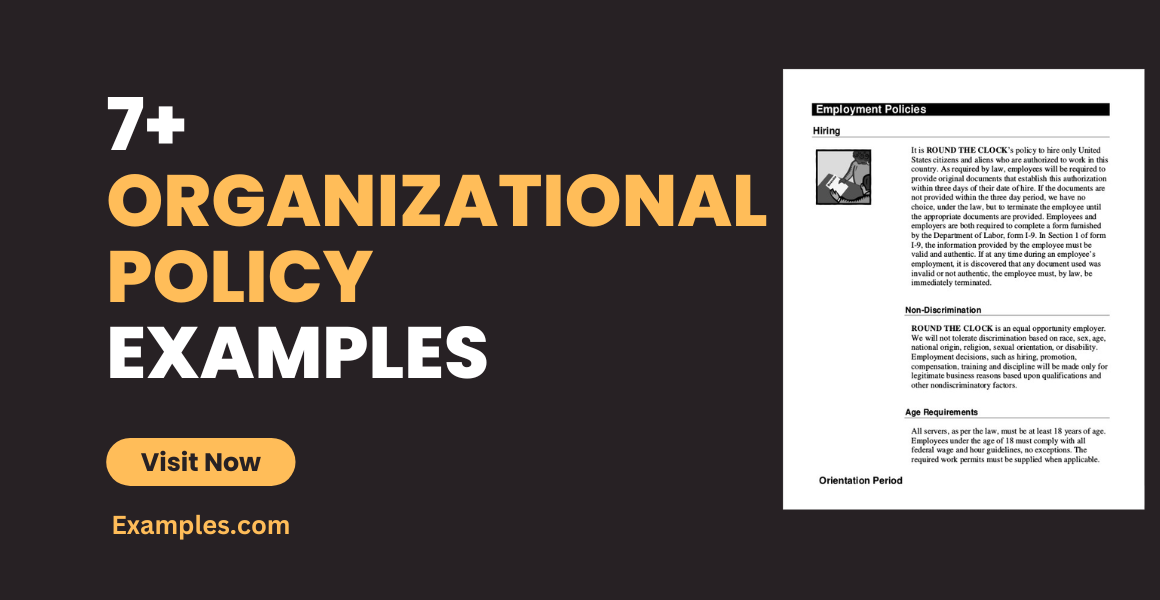
A workplace without rules and policies for workers to abide to is certainly a recipe for disaster. Policies serve a vital purpose in strengthening, supporting, and protecting an organization and its people. These are applied to form boundaries for acceptable behavior within the workplace, and serve as a guideline for the best practices in particular office situations. This is done to ingrain values and norms that contribute to the general culture of the company as well. You may also see marketing policy.

Policies and Procedures in Business
Company policies and procedures are an essential part of any given organization. These are employed to protect the rights of company employees as well as the interests of employers. This is to establish the rules of conduct within an entity, outlining the function of both employers and the organization’s workers. This may include employee conduct, dress code, attendance, privacy, and other related conditions, depending on the needs of the organization.
Initiating structured policies and procedures can aid an organization in running more effectively and systematically. With this, members of the organization are provided a simplified description and a deeper understanding of the formal structure of the organization they are a part of.You may also see training policy.
One example of a policy that must be implemented to guide the company in achieving its defined objectives are the organization’s financial policies. This policy would help monitor and manage the financial expenditures of the company, along with tracking all monetary transactions and applying adequate statutory reporting requirements. The company must also establish a mechanism that ensures accurate and timely recording of every financial data to the management responsible for handling these reports.You may also see drug and alcohol policy.
In applying new organizational policies, the organization must see to it that its entire staff becomes a fundamental part of these changes. In most cases, the organization would conduct employee surveys to point out key issues that may be affecting the overall structure of the company before these policies have been applied. Apart from asking specific questions that center on the organization as a whole, the survey must also include general questions regarding its respondents. This includes a list of their responsibilities, the entity’s chain of command, as well as organizational reporting mechanisms that exist.You may also see employee email policy.
Additionally, seeing how new policies may affect the company’s current day-to-day operations must also be considered beforehand. To do so, the organization must examine the specific roles of staff members, observe how they utilize their time, study the current workflow layout, and analyze the organization’s past performances.You may also see disciplinary action policy.
However, it’s also important to take note that the company may not fully assess the impact of the new organizational policies unless it has already been implemented. Here, the organization must evaluate and compare the mission and vision statements of the company, as well as the strategic objectives needed to achieve the company’s business goals, before and after the policy has been applied. If these changes prove to be beneficial, then they are likely to notice a boost in performance in most sectors within the organization.You may also see non-discrimination policy.
Organization Termination Policy Example
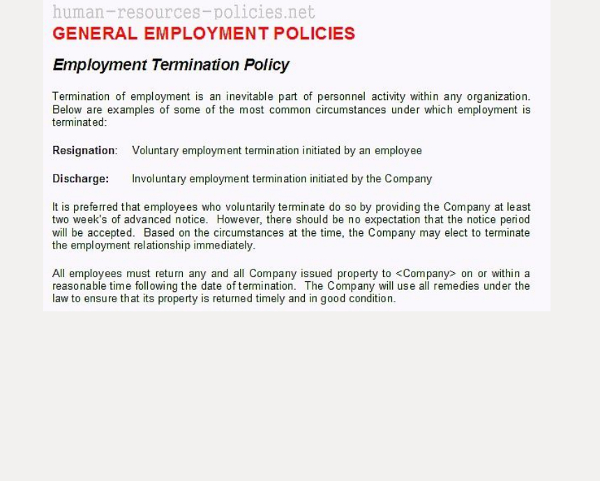
totallylocalhr.com
Details
File Format
PDF
Size: 63 KB
Restaurant Organization Policy Example
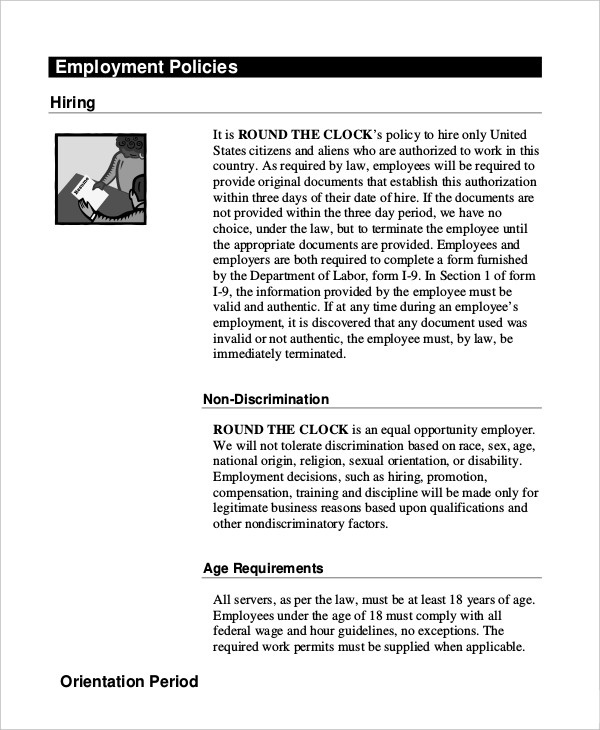
ender.realtypark.co
Details
File Format
PDF
Size: 75 KB
Employeee Handbook Staff Policy Example
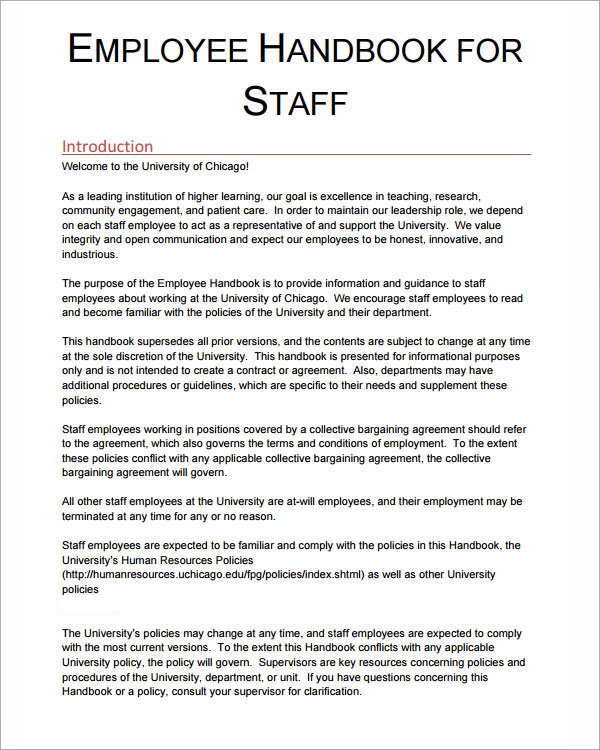
ender.realtypark.co
Details
File Format
PDF
Size: 97 KB
The Purpose of Policies in the Workplace
Now that we have tackled the general function of policies in a corporate setting, let’s take a deeper look at how these policies work:
Policy Handbooks
Most, if not all, corporate policies are conveyed to company employees through a policy handbook or manual. The document typically covers a wide range of topics and general categories that workers must be aware of such as professional etiquette, proper dress code, and standard work procedures. It also addresses specific subjects and policies that are exclusive to the organization. Though these handbooks are usually provided to new recruits during orientation, some companies create an internal mode of communication, like emails and printed business documents, to update employees on changes or new policies that are not found in the existing manual. You may also see vacation policy.
Uniformity
Uniformity, in terms of employee rights and responsibilities, is an important factor in maintaining harmony within the workplace. Without the guidance of a policy, various problems and issue may arise and affect significant business operations in the worst possible way. Because one’s personal standards may vary from that of another individual, this is likely to cause internal conflict.You may also see recruitment policy.
For instance, some employees might opt for a business attire in the office setting, while others would be more comfortable with a simple t-shirt and jeans combination. If consistency in the workplace is of primary importance to the organization, then implementing a policy to address this concern would be necessary.
Best Practices
Companies that have been running for several years eventually recognize what decisions and actions greatly affect the performance of an organization. Some minor policies are employed to keep workers in line with directions and procedures that may benefit their department. Say for example, sales representatives frequently face clients and customers as part of their job role. Knowing this, it’s important to implement policies that address their appearance, etiquette, and communication capacities when dealing with prospects. Considering the nature of their job, these policies greatly influence the level of success acquired in generating new customers and encouraging repeat business. This will help the organization improve productivity within a sector, which in turn, affects the overall business performance.You may also see email policy.
Safety
Bear in mind that policies may also cover legal and ethical safety aspects of the organization, including the personal safety of its employees. Meeting legal requirements should be a primary goal when developing a policy. This is especially important for companies running construction sites, warehouses, and plants that deal with dangerous equipment and manual labor. By establishing policies that address these concerns, this will pertain workers from engaging in activities that may get them, and the organization, in deep trouble. This can also help prevent probable injuries, and spare the company from possible lawsuits.You may also see travel expense policy.
Limitations
There are cases where an organization fails to acknowledge the general purpose of a policy. This leads to the implementation of policies that keep employees on a short leash. Excessive policies, or those that oppose company culture and hinder creative thinking, are bound to generate poor, bottom line outcomes. You may also see leave policy.
Employee Handbook Policy Example

ender.realtypark.co
Details
File Format
PDF
Size: 131KB
Handbook Policy Template Example
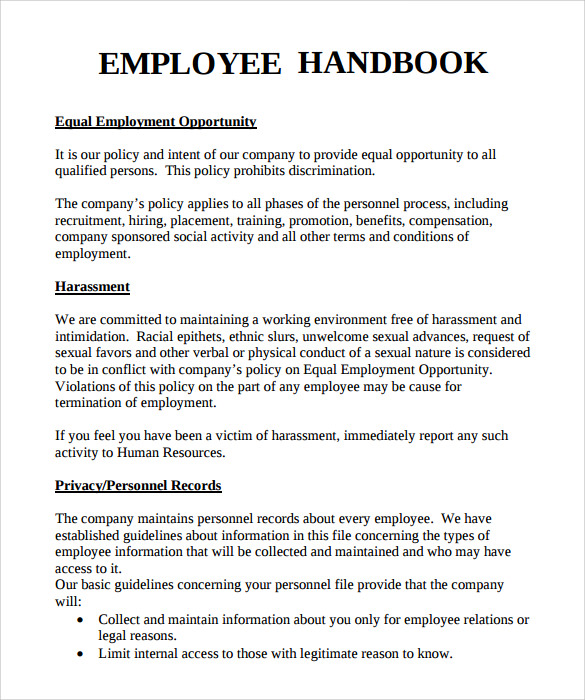
ender.realtypark.co
Details
File Format
PDF
Size: 82 KB
Leave Organization Policy Example
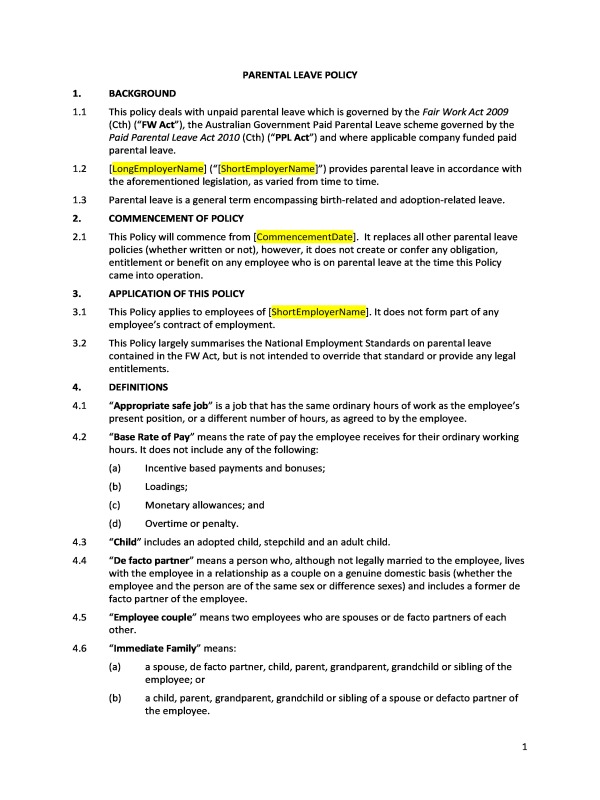
hradvance.com.au
Details
File Format
PDF
Size: 82 KB
How to Develop Organizational Policies
Developing organizational policies is a long, daunting task that must be administered carefully. To guide you through this process, refer to the stages that follow:
1. Identify the Need for it.
A policy can be developed for two reasons: in anticipation of a need and in response to a need. This is why an organization must constantly examine its current activities, work responsibilities, and external environment in order to pinpoint the need for such policies and procedures. This ensures that the implemented policies can actually contribute to the organization in a positive way, instead of wasting time and resources on ineffective policies.You may also see smoking policy.
2. Determine Who Takes the Lead.
When developing corporate policies, there must be a specified group of individuals assigned to study and assess existing problems and their proposed solutions. This responsibility must be appointed to an individual, a working group, or a sub-committee, consisting of members that possess expertise in the designated field. This guarantees that the policy is made based on reliable data and professional knowledge. You may also see dispute resolution policy.
3. Gather Information.
Before you begin creating an outline of your policy, make sure you do your research first. Since policies are ideally built on a legal foundation, it’s important that your policies conform to these standards. Your understanding on a certain matter must also be accurate and up to date. If other organizations have tackled similar issues in the past, then you can use this as your point of reference. You may also utilize various policy examples and templates for guidance.You may also see policy examples.
4. Create a Draft.
When writing a business or a technical document, it’s always good to start with a draft. This will make it easier to apply any necessary changes to the paper. You should also ensure that the wording and complexity of the proposed policy are suitable to those who are set to effectuate it.
5. Consult with Stakeholders.
Organizational policies are most effective when those involved or affected by it are first consulted. This will give stakeholders the opportunity to become a part of the whole process. This way, they may identify any lapses presented in the document, or possible concerns that need to be addressed before anything blows out of proportion. Depending on the focus of the said policy, the entities you wish to consult may include supporters, staff members, the management committee, and other beneficiaries.You may also see appraisal policy examples.
6. Finalize the Policy.
Once you have a proposed policy in place, you then need to have it approved by the authorized individuals. In most instances, the management committee is held responsible for all policies and procedures that are submitted and accepted within the organization.
6. Consider Essential Procedures.
Most policies require the presence of certain procedures for them to be formally implemented. This could involve the support of another policy, and the guidance of particular individuals. This may even include a different set of processes that must be carried out for consultation, approval, and implementation.You may also see insurance policy.
7. Implement.
Once the policy has been reviewed and is ready to go, the organization must then look for an appropriate channel to communicate these plans or changes with its intended audience. For policies that concern external entities, then a mass release may be considered. As for the organization’s internal assets, you must consider the actions that would follow once the policy is successfully implemented.
8. Review
By the time the policy has been applied, the organization must then monitor, review, and revise whatever needs to be altered. Assessing the usage and responses obtained from these policies will help you locate any loopholes that need to be attended to immediately. Once this is done, the organization may then apply the necessary changes to ensure a smooth flow in business operations.You may also see petty cash policy.
Organization Whisteblower Policy Example
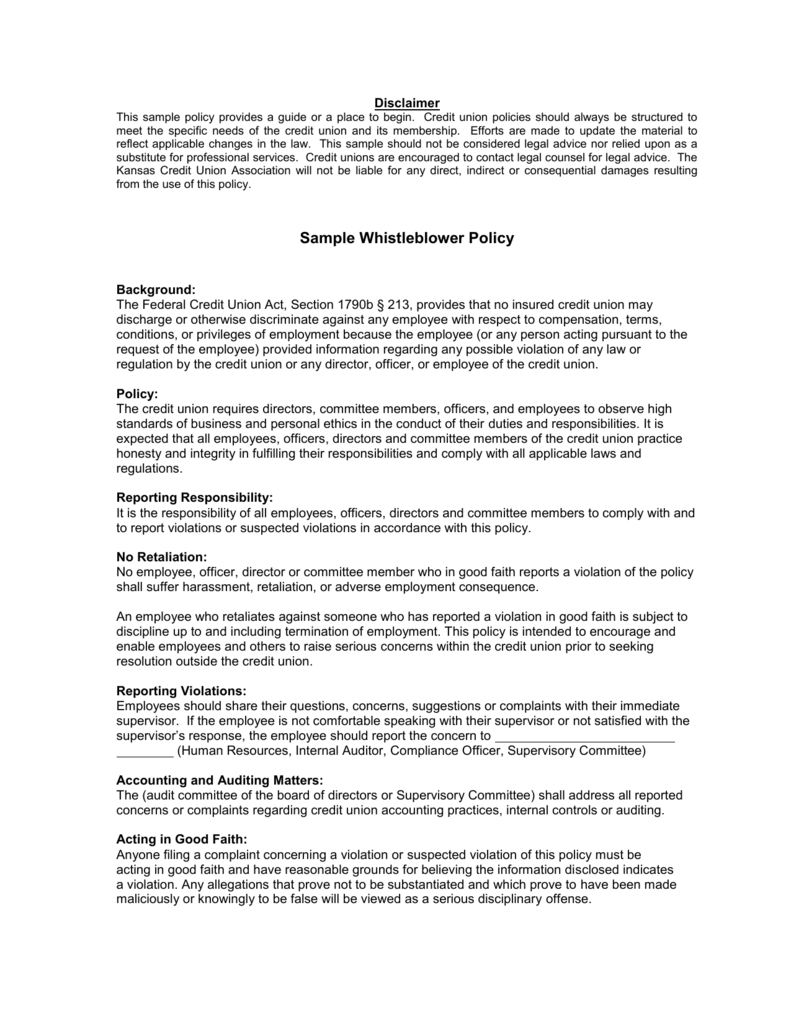
studylib.net
Details
File Format
PDF
Size: 136 KB
It is critical that business executives recognize the value and role of policies in maintaining clarity, consistency, and safety in the workplace. Through this, employees develop a better understanding of the management’s attitude towards these rules and the consequences they could face once these policies are violated. This is an essential piece of communication that promotes clear messaging from executives, as well as inclusive employee training to obtain a healthy working environment for staff members of an organization.You may also see complaint policy.

